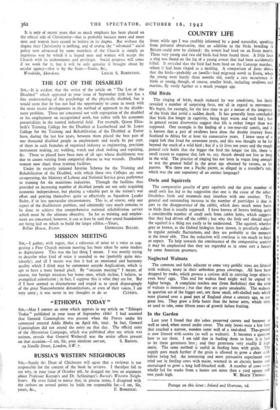COUNTRY LIFE
SOME while ago I was credibly informed by a good naturalist, speaking from personal observation, that an addition to the birds breeding in Britain could now be claimed: the avocet had bred on an Essex marsh. Three very young and two old birds had been found there. A little later a ring was found on the leg of a young avocet that had been accidentally killed. It revealed that the bird had been bred on the Camarge marshes, -where it had_been ringed as a nestling. A comparison of dates shows that the birds—probably en famille—had migrated north to Essex, when the young were barely three months old, surely a rare occurrence in birds so young, though, of course, smaller birds, including swallows and martins, fly vastly further at a much younger age.
Old Birds The ringing of birds, much reduced by war conditions, has lately revealed a number of surprising facts, not all in regard to movement We begin, for example for the first time to get a notion of the longevity of the birds that avoid a sudden death. It has generally been concluded that birds live longer in captivity, being kept warm and well fed ; but in general recent discoveries suggest that life is rather longer than was supposed. One example is the finding of a ten-year-old tomtit, and it is known that a pair of swallows have done the double journey from Scotland to Africa for at least six consecutive years. I knew once of a caged lark that lived for seventeen years, and this was thought to be far beyond the reach of a wild bird ; but if a tit lives ten years and the rough general rule holds that the bigger the bird the longer the life, there is small reason to suppose that lark or, say, thrush should not live as long in the wild. The practice of ringing has not been in vogue long enough to test the general belief in the great age obtained by ravens, as by parrots. Was there not a Pacific parrot, as alleged in a traveller's tale, which was the sole repository of an extinct language?
Owls and Squirrels
The comparative paucity of grey squirrels and the great number of small owls has led to the suggestion that one is the cause of the other. Doubtless birds and mammals may interfere with one another. The general and outstanding increase in the number of partridges is due in part to the disappearance of the rabbit, which does much more harm to birds than is usually supposed. I have known of ferrets bolting quite a considerable number of small owls from rabbit holes, which suggests that they had driven off the rabbit ; but why the little owl should expel the squirrel is a thing not easily to be understood. The squirrel, whether grey or brown, as the Oxford biologists have shown, is peculiarly subject to regular periodic fluctuations and they are probably at the moment at the lower ebb. That the reduction will continue is too much to hope Or expect. To help towards the continuance of the comparative scarcity it may be emphasised that they are regarded as in some sort a luxury by some American gourmets.
Neglected Walnuts The common and fields adjacent to some very prolific trees are littered with walnuts, many in their unbroken green coverings. All have been dropped by rooks, which possess a curious skill in carrying large objects, even hens' eggs. This zeal for walnut food might well be copied by higher beings. A complaint reaches one (from Berkshire) that the crop of walnuts is immense ; but that they are quite unsaleable. The walnuts in question are of the bigger sort, not those small, soft-shelled nuts which were planted over a good part of England about a century ago, to our great loss. They grew a little faster than the better sorts, which take, or used to take, some fifteen years of growth before fruiting.
In the Garden Last year I found that dry.ashes preserved carrots and beetroot as well as sand, when stored under cover. The only losses were a few beet that touched a narrow, wooden outer wall of a tool-shed. The. ground is now littered with acorns (as well as walnuts). It becomes a question how to use them. I am told that in feeding them to hens it is best to let them germinate first ; and they germinate very readily if kept moist. The same method is useful in feeding hens with grain. The supply goes much further if the grain is allowed to grow a short stalk before being fed. An interesting and most persuasive experiment was tried out in feeding cows with maize, warmed in an electric. heater and encouraged to grow a long half-bleached stalk. A number of cows were wholly fed for weeks from a heater not more than a yard square and
Postage on this issue : Inland and Overseas, id.


























 Previous page
Previous page